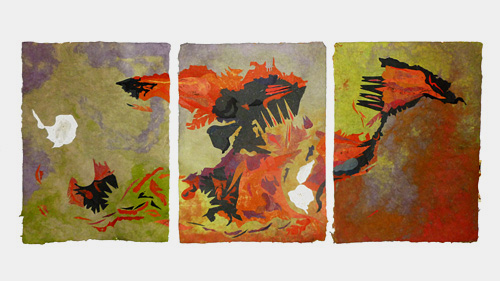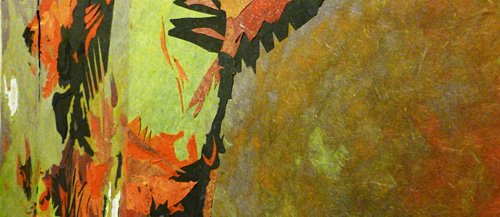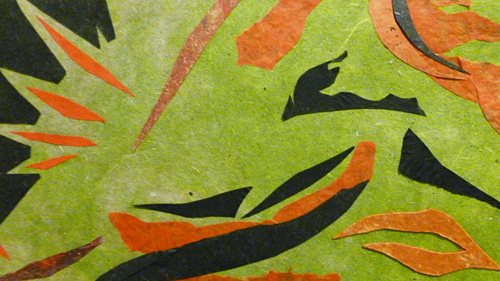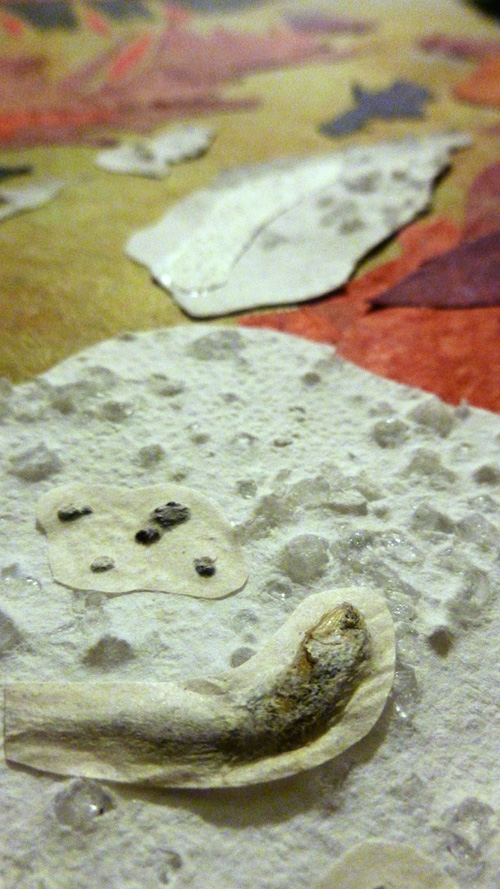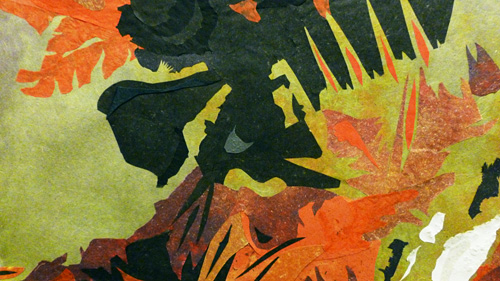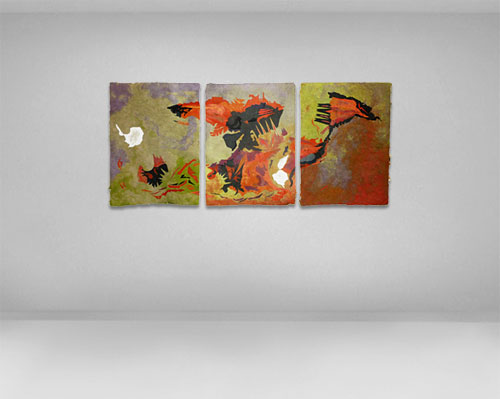 |
WALL MAP
Psyche-Anthropocene Projection
2013
Handmade paper, inclusions, PVA
30 x 70 x 1.5 inches (installed) (each panel 30 x 22)
Psyche-Anthropocene Projection is a world map emotionally predicting the terrifying future of our planet’s biomes as they experience climate change.
Emotionally, this map represents the fear I feel when researching the implications of climate change. What does it mean to exist in a warmer world? How will communities deal with the massive changes ahead? If historical events can shed any light, and if contemporary events can be viewed in a broader context, we can predict a miserable outcome. War, disease, starvation, dehydration, death, poverty, pollution, contamination, surveillance, despotism, discrimination, fascism, militarization, corporatization, prisons, massacres, protests, agent provocateurs, conspiracies, assassinations, chaos. In the context of the seemingly endless struggle between labor and capital, the future of the planet, as depicted in this map, is a battleground. The People are many, and they will be suffering, exploited, cast into the dangerous new world of scarce natural resources, left to fight for their right to basic necessities. The Elite plutocrats will be few but enormously powerful in their sway over laws (and their enforcement or lack thereof) and militaries (ironically made up of the oppressed, The People), and their possession of highly sophisticated technology meant to control civilian populations in times of unrest. This map represents my pessimism in light of political and environmental status quo.
In this warmer world, desertification runs rampant, expanding current desert borders well beyond their boundaries. Black fragments of handmade paper represent these desert biomes, emotionally charged with tones of depression, oppression, and the appearance of a scorched earth.
Wild shades of red and purple handmade paper, embedded with sand, rocks, twigs, and soil, represent biomes that will experience extreme weather events alongside natural resource depletion. These highly negative aspects of climate change will increase violence in these regions, as survivors fight over scare water and food supplies. Climate refugees will clamor to inhabit regions with more viable water and food resources, crowding these areas with malnourished and desperate women, children, and men. The small elite ruling class of plutocrats will have few options but to live in these contentious areas, and they will protect their property with private militaries armed with sophisticated surveillance, intelligence, and technologies capable of mass destruction. The distinction between the wealthy elite and the impoverished masses will reveal the major underlying class conflict that has always existed in this country. Will class-consciousness rally the 99% against their historical oppressors?
Rising sea levels and extreme weather events will render many coastal areas uninhabitable. In this map of emotional geography, the cities and towns abandoned by their citizens, are eyed for nefarious purposes by those with capital and power to do so. Many coasts are highly militarized zones with intense earth modification projects intended to better allow the military to control these regions and to create massive ports for commercial shipping (with the military, of course, protecting the interests of the corporations shipping materials and goods). The refugees of these regions, carrying with them the last vestiges of their cultures, are all that stand in the way of its complete destruction. The sharp angled, geometrically cut black paper used to defines these regions are the reclaimed negative space of another series of environmental works, Indigenous Unite!. From the ferocious uniform of The Military, a portrait of the guards of the ruling class, come these protruding coastlines.
In this warmer world, the seas are a churning amalgam of toxic waste, debris, and radioactive contamination. Harmful algal blooms choke remaining sea life as they proliferate in overly-fertilized runoff waters near agricultural coasts, particularly affecting local fishing communities who once relied on this source of nourishment. In the new, warmer oceans, most large and complex forms of sea life have disappeared, gone extinct. Only simpler forms of life can manage to exist in these waters; sea jellies proliferate, banding together in swarms of slow moving gelatinous stinging tides.
This world map deviates from the commonly used Mercator Projection of the planet. Any attempt to represent a globe on a flat surface presents the problem of accuracy and so the cartographer must choose which distortions to allow and which physical features to faithfully represent. In this map I’ve selected a projection similar to the Transverse Mercator, a version with a rarely chosen central meridian, providing a seemingly bizarre representation of our home planet. Literally helping us to see the world in a different way, this map aims to instigate a desire within the viewer to join socially engaged movements attempting to stop the insane destruction of the planet’s livable biomes and their inhabitants.
|






